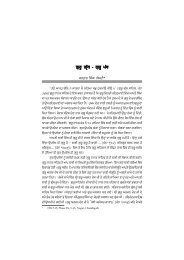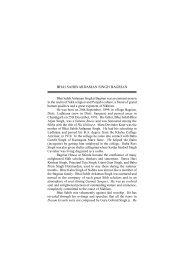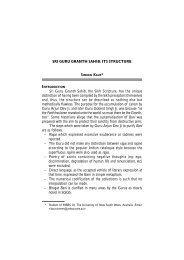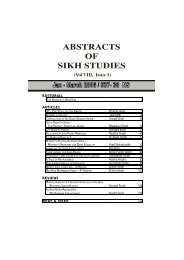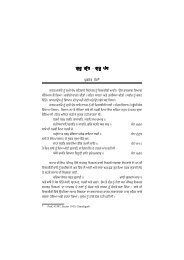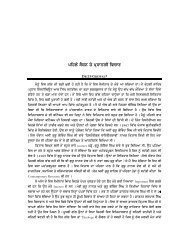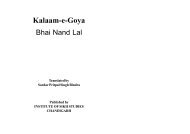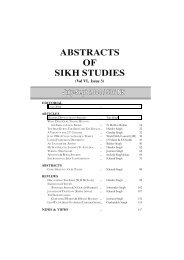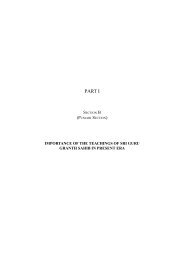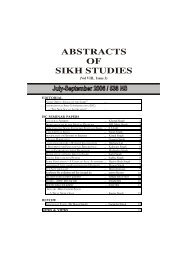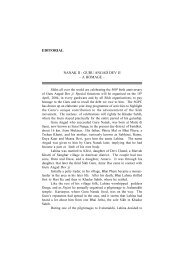editorial articles reviews news & views - Institute of Sikh Studies
editorial articles reviews news & views - Institute of Sikh Studies
editorial articles reviews news & views - Institute of Sikh Studies
You also want an ePaper? Increase the reach of your titles
YUMPU automatically turns print PDFs into web optimized ePapers that Google loves.
THE OTHER SIKHS – A VIEW FROM EASTERN INDIA<br />
105<br />
third <strong>of</strong> Cuttack division. <strong>Sikh</strong> studies in Orissa were mostly pioneered<br />
by Brahmo Samaj in Puri. People like Madhusudan Rao, found<br />
similarity in Guru Nanak and Brahmo preachings. Sevak, a weekly,<br />
published three successive <strong>articles</strong> on Guru Nanak. Fakirmohan<br />
Senapati covered <strong>Sikh</strong> history <strong>of</strong> 250 years from Guru Nanak to Banda<br />
Bahadur. In his poem Saptarshi he quotes the Guru extensively. But<br />
Brahmos never got genuinely interested in Khalsas’ message <strong>of</strong> military<br />
resistance. In their literary journal Satyabadi and <strong>news</strong>paper Samaj,<br />
they compared Oriya’s freedom movement with the <strong>Sikh</strong>s’ Gurdwara<br />
reform movement. Chandramani Das’ Nanak is Guru’s Oriya biography<br />
in book form. Naba Kishore’s poem about Guru Gobind Singh, projects<br />
him as a soul <strong>of</strong> generosity. Lingaraj Mishra’s book Guru Gobinda<br />
Singha eulogizes his life, though Chintamani Acharya had a different<br />
mindset. Ghosal’s book conveyed a lesson from the way the <strong>Sikh</strong>s<br />
marched towards freedom from a political morass. The author salutes<br />
<strong>Sikh</strong>s for their love <strong>of</strong> freedom and martyrdom. Siva Prasad Das’ <strong>Sikh</strong><br />
Prakash is mentioned as extensive history <strong>of</strong> <strong>Sikh</strong>s from Guru Nanak<br />
to the Second <strong>Sikh</strong> war. He shows blatant loyalty to the British. Oriya<br />
press like Samaj and Utkal Dipika aroused the sentiments <strong>of</strong> Oriyas in<br />
favour <strong>of</strong> Akali agitation against bloody turn at Nankana Sahib, Guru<br />
ka Bagh, Jaito and such other places. <strong>Sikh</strong> studies in Orissa spread<br />
over a large area like Cuttack, Baripada, Balasore Berhanpore and<br />
Sambalpore . However, the small number <strong>of</strong> Oriya <strong>Sikh</strong>s was a<br />
handicap in bringing out authentic Oriya books on <strong>Sikh</strong>ism except<br />
<strong>Sikh</strong> Prakash, a commendable book. This was compensated by Oriya<br />
press coverage in the wake <strong>of</strong> non-cooperation movement and Akali<br />
agitation in the 20 th century.<br />
STUDIES IN BENGAL<br />
The author devotes two elaborate chapters about Bengalis and<br />
<strong>Sikh</strong> studies. He is confining to the first 250 years, i.e., Guru period<br />
out <strong>of</strong> 500 years <strong>of</strong> <strong>Sikh</strong> history. Bengali Brahmos pioneered the work.<br />
Raja Ram Mohan Roy, drawing similarity between Brahmos and Guru<br />
Nanak, drafted his famous book Sketch <strong>of</strong> the <strong>Sikh</strong>s. His narration<br />
covers Gurdwara Badi <strong>Sikh</strong> sangat in Calcutta, “Alakh Niranjan”<br />
salutation, <strong>Sikh</strong> shabads being sung at Brahmos meetings, as also Guru<br />
Nanak’s <strong>views</strong> against idolatry and casteism. Akshay Kumar Datta



